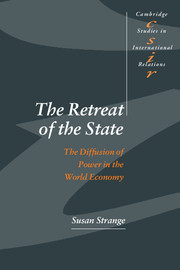Book contents
2 - Patterns of power
from Part I - Theoretical foundations
Published online by Cambridge University Press: 07 October 2009
Summary
It will be no use my going through the evidence to sustain my three propositions about the shifting patterns of power in world politics unless there is some agreement – or at least comprehension – on the part of the reader concerning two fundamentals – power, and politics. My whole argument rests on a much broader definition of both than is usually encountered by students of politics in the western liberal tradition. This chapter is devoted to the arguments for a broader definition, and against narrower, more conventional ones. The next one is devoted to the definition of politics. What do we mean when we talk about ‘political issues’ or ‘political disagreements’? Are we concerned only with what politicians do, or only about what transpires in political institutions? If you are not interested in such rather abstract notions, by all means skip on to chapter 4. But please do not complain at the end of the book that you cannot accept the conclusions because they are based on ideas that conflict with what is generally understood by the concept of Power, or because they do not accord with commonly accepted ideas about the proper limits of politics, including both the who and the what – who engages in politics, and what they take responsibility for when they do. At least, consider the case for expanding these conventional notions about power and politics, and for applying the broader concepts to questions of change in the international political economy.
- Type
- Chapter
- Information
- The Retreat of the StateThe Diffusion of Power in the World Economy, pp. 16 - 30Publisher: Cambridge University PressPrint publication year: 1996
- 1
- Cited by

